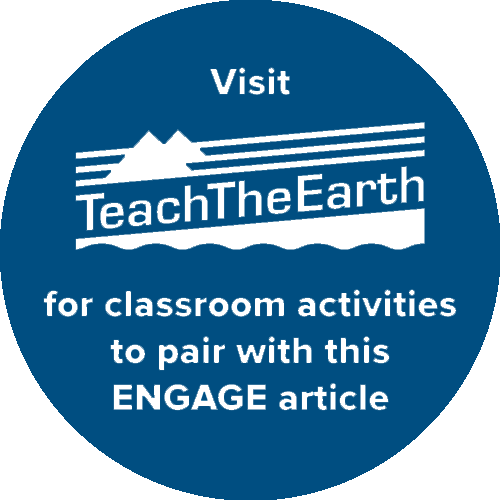The Anaktuvuk River Fire in 2007 tore through 100,000 hectares of Alaskan tundra in almost 3 months of continuous burning. This fire not only changed the area vegetation, but it also thawed permafrost and led to the formation of thermokarst. This is a dramatic example but may serve as a bellwether incident for climate to come.
“Almost everything hinges on permafrost in the Arctic ecosystem.”
Arctic permafrost stores 33% of Earth’s organic carbon, even though it covers only 20% of the planet. It also acts as the structural foundation, physically and ecologically, for the entire pan-Arctic region. Permafrost thawing has cascading effects on the hydrological conditions of the landscape and ice and also triggers changes in vegetation and releases stored carbon. “Almost everything hinges on permafrost in the Arctic ecosystem,” said Yaping Chen, a postdoctoral research associate at the College of William and Mary’s Virginia Institute of Marine Science.
Yet there are still questions about how fires (the incidence of which is increasing in the Arctic) and climate change might increase the amount of thermokarst—the uneven land formed after permafrost melts. Thermokarst is the result of the degradation of permafrost and provides reduced carbon sequestration and fewer niche ecosystems than permafrost.
We have poor knowledge about the presence of permafrost, said Chen. We don’t know exactly where it is or how much there is of it. “These difficulties make it very hard to predict where thermokarst may start and how it will develop over time,” she said.
Fire’s Long Tail
In the longest temporal study done yet, Chen and her colleagues analyzed 7 decades of extremely high resolution imagery to better understand how fires and climate change stimulate thermokarst formation. They focused on the Noatak National Preserve in Alaska because it’s warm, it’s getting warmer—already 2.1°C warmer than it was in 1950—and it had the most fires during the period studied. Overall, researchers found that between 1950 and 2015, the incidence of thermokarst formation increased by 60% because of the combination of wildfires and climate change. The findings were published in One Earth.
“Our major result is that although fire only burned about 3% of the Arctic landscape, it is responsible for more than 10% of thermokarst formation,” said Chen. “However, climate change remains the predominant regional consideration of thermokarst formation.”
Researchers also found that fires increased thermokarst formation for up to 80 years postfire, much longer, said Chen, than previously thought. “Normally people didn’t think fire is an important factor because it doesn’t occur often in tundra ecosystems, but our finding supported that fire is actually very important,” she said. In boreal forests, such a formation lasts approximately 2–3 decades.
“Climate change is really doing the work here.”
Once thermokarst releases ancient carbon from the soil, the soil may never recover, said Chen. And with predicted increases in Arctic fires, these effects will become more consequential. Apart from releasing carbon into the atmosphere, the disappearance of permafrost also threatens infrastructure and communities that are built on it.
This study is “a significant piece of work,” said Antoni Lewkowicz, a professor of geography, environment, and geomatics at the University of Ottawa who was not involved with the research. “Climate change is really doing the work here,” he said. “Summer air temperatures are the driver of this thermokarst change, and hot summers, which were very rare in the past, are becoming more and more common, and it’s those extreme, hot summers that are really making the difference.”
Ground Change
Undisturbed permafrost is covered by an insulating layer of vegetation and organic matter, which protects it from climate change. But when there’s a fire, this protection is burned away, and the permafrost is exposed to warming temperatures. This is when it begins to collapse into thermokarst. Fires also deposit a layer of charcoal on the ground, explained Chen, which changes the ground’s albedo and results in the area absorbing more energy than the surrounding unburned area, meaning that it’s warmer. “This is another positive feedback that causes permafrost to thaw,” said Chen.
“We are creating larger consequences on the global climate ecosystem.”
Repeat burning, however, does not result in more thermokarst, the researchers found. That’s because the first fire changes the soil. Permafrost thaw, unsurprisingly, makes the ground wetter and therefore less easy to burn. But the first fire also supports the growth of more burn-resistant species as tundra vegetation, said Chen. These species store less carbon than traditional tundra plants such as mosses and shrubs. Over time, the entire landscape may drain and export carbon and freshwater into the Arctic Ocean or nearby rivers. This water may also release methane, she said. “When the landscape drains, it actually makes the ground drier and creates a positive impact on future fire to occur,” said Chen.
The researchers, said Chen, want to investigate the larger impact of this permafrost change on the wider ecosystem, including how much carbon was released and how hydrological regimes in different areas have been altered. They also plan on testing their findings in other Arctic areas, including Siberia, where wildfires in 2021 burned almost 20 million hectares.
“In the future, we definitely expect to see more rapid and more expansive permafrost thaw,” said Chen. “We are creating larger consequences for the global climate ecosystem.”
—Danielle Beurteaux (@daniellebeurt), Science Writer
This news article is included in our ENGAGE resource for educators seeking science news for their classroom lessons. Browse all ENGAGE articles, and share with your fellow educators how you integrated the article into an activity in the comments section below.


